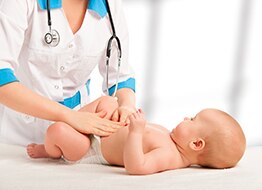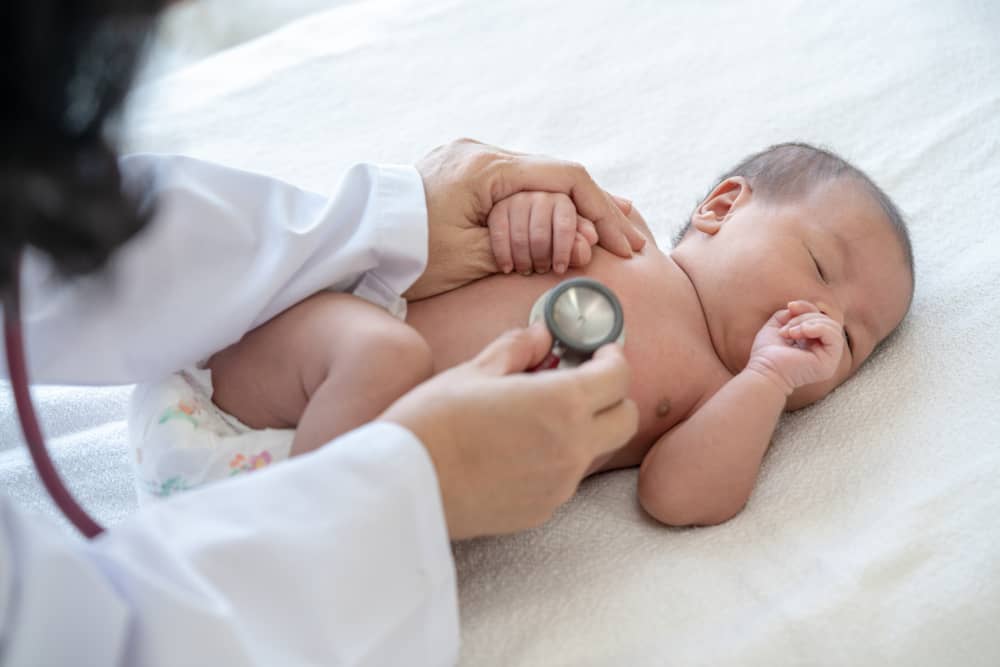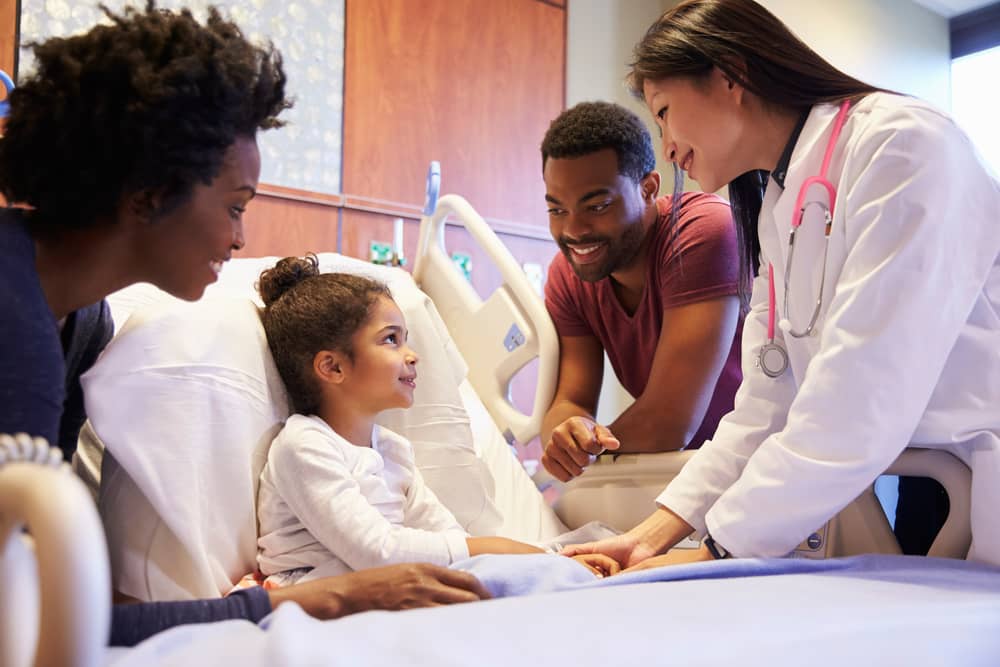Hirschsprung Disease
Return to Overview PageDefinition & Facts
In this section:
- What is Hirschsprung disease?
- Are there different types of Hirschsprung disease?
- How common is Hirschsprung disease?
- Who is more likely to have Hirschsprung disease?
- What other conditions do people with Hirschsprung disease have?
- What are the complications of Hirschsprung disease?
What is Hirschsprung disease?
Hirschsprung disease is a birth defect in which some nerve cells are missing in the large intestine, so a child’s intestine can’t move stool normally and becomes blocked.
Are there different types of Hirschsprung disease?
The major types of Hirschsprung disease are
- short-segment Hirschsprung disease, in which nerve cells are missing from the rectum and sometimes the lower part of the colon, called the sigmoid colon.
- long-segment Hirschsprung disease, in which nerve cells are missing from the rectum and a longer part of the colon than in short-segment Hirschsprung disease, but nerve cells are present in at least part of the colon.
- total colonic Hirschsprung disease, in which nerve cells are missing from the rectum and the entire colon, but are present in the end of the small intestine.
- small intestinal Hirschsprung disease, in which nerve cells are missing from the rectum, colon, and the end of the small intestine, but are present in the rest of the small intestine.
- total intestinal Hirschsprung disease, in which nerve cells are missing from the rectum, colon, and all, or nearly all, of the small intestine.
In a child with Hirschsprung disease, stool moves through the intestines until it reaches the part lacking nerve cells. At that point, the stool moves slowly or stops.
About 80% of children with Hirschsprung disease have the short-segment type.1 In about 5% to 10% of children with Hirschsprung disease, nerve cells are missing from all of the large intestine and sometimes from part of the small intestine.2
How common is Hirschsprung disease?
About 1 in 5,000 newborns has Hirschsprung disease.3
Who is more likely to have Hirschsprung disease?
Hirschsprung disease is more likely to affect
- boys. Hirschsprung disease is about 3 to 4 times more common in boys than in girls.1,4
- children who have a sibling or parent with Hirschsprung disease.
- infants and young children. Hirschsprung disease is present at birth. Some children develop signs and symptoms and are diagnosed shortly after birth. However, others may develop symptoms and be diagnosed later in infancy or early childhood. About half of all children with Hirschsprung disease are diagnosed in the first year of life.1,5 About 80% are diagnosed by age 7.1,5
What other conditions do people with Hirschsprung disease have?
About 30% of children born with Hirschsprung disease also have other conditions, such as1,6
- birth defects that affect other parts of the body, such as the heart, head or face, hands, or digestive tract
- Down syndrome and certain other chromosomal disorders
What are the complications of Hirschsprung disease?
Hirschsprung disease may lead to Hirschsprung-associated enterocolitis and other complications.
Hirschsprung-associated enterocolitis
The most common complication of Hirschsprung disease is Hirschsprung-associated enterocolitis, a condition in which the intestines become inflamed. This complication may occur before or after a child has surgery to treat Hirschsprung disease.
Symptoms of Hirschsprung-associated enterocolitis may include
- swelling of the abdomen
- fever
- diarrhea
- vomiting
- lack of energy
- rectal bleeding
- shock
Anyone with Hirschsprung disease who has symptoms of Hirschsprung-associated enterocolitis needs to go to the hospital right away. This condition can be life-threatening.
 Anyone with Hirschsprung disease who has symptoms of Hirschsprung-associated enterocolitis needs to go to the hospital right away.
Anyone with Hirschsprung disease who has symptoms of Hirschsprung-associated enterocolitis needs to go to the hospital right away.Other complications
Other possible complications of Hirschsprung disease include
- soiling, or when a child has accidental bowel movements in their underwear
- megacolon, or severe constipation and swelling of the intestine
- malnutrition, or when a child doesn’t get enough vitamins, minerals, and other nutrients to grow and be healthy
- perforation, or a hole in the wall of the intestine, which is more common in newborns than in older children
References
Symptoms & Causes
What are the symptoms of Hirschsprung disease?
Symptoms of Hirschsprung disease vary. Signs or symptoms in newborns may be different than symptoms in older infants, children, and adults.
Signs and symptoms in newborn infants
Some infants with Hirschsprung disease have signs and symptoms of intestinal obstruction shortly after they are born, which include7,8
- not having a first bowel movement within 48 hours after birth
- green or brown vomit
- swollen abdomen, or belly
- problems feeding
- explosive stools or diarrhea after a doctor inserts a finger into the newborn’s rectum
Symptoms in older infants, children, and adults
Children with Hirschsprung disease who don’t have signs and symptoms of intestinal obstruction at birth may not be diagnosed and treated until they are older. Common symptoms in older infants and children include
- chronic constipation that doesn’t get better after treatment with oral laxatives—laxatives that are taken by mouth
- swollen abdomen
- malnutrition or failure to thrive, meaning that an infant or child weighs less or is gaining less weight than expected for his or her age
- symptoms of Hirschsprung-associated enterocolitis, such as diarrhea
 Symptoms of Hirschsprung disease may include swelling of the abdomen.
Symptoms of Hirschsprung disease may include swelling of the abdomen.
In older infants and children, symptoms of Hirschsprung disease, such as constipation, may be similar to symptoms of other conditions. Therefore, doctors may not suspect and diagnose Hirschsprung disease right away.
In rare cases, Hirschsprung isn’t diagnosed and treated until adulthood. Adults with Hirschsprung disease typically have a history of abdominal swelling and chronic constipation that doesn’t get better after taking oral laxatives.
What causes Hirschsprung disease?
Hirschsprung disease occurs when nerve cells in the intestines don’t develop normally before an infant is born. Experts are still studying factors that may cause problems with how these nerve cells grow.
Certain genes increase the chance that a child will have Hirschsprung disease. Experts think that several different genes may play a role.
References
Diagnosis
How do doctors diagnose Hirschsprung disease?
Doctors diagnose Hirschsprung disease by taking a medical and family history, doing a physical exam, and ordering tests.
Although Hirschsprung disease develops before birth, doctors cannot diagnose the disease until after an infant is born. About half the people with Hirschsprung disease are diagnosed in their first year of life.9,10 About 80% of people with Hirschsprung disease are diagnosed by age 7, and more than 90% are diagnosed by age 13.9,10
If your child’s doctor suspects your child might have Hirschsprung disease, he or she may refer your child to a pediatric gastroenterologist—a doctor who specializes in digestive diseases in children—or a pediatric surgeon.
Medical and family history
To diagnose Hirschsprung disease, a doctor will start by asking about your child’s medical and family history. The doctor will also ask about your child’s symptoms and when the symptoms began.
Physical exam
During a physical exam, a doctor typically
- reviews your child’s height and weight
- examines your child’s abdomen—or belly—for swelling
- performs a digital rectal exam—having no stool in the rectum or having explosive stool after a rectal exam may be signs of Hirschsprung disease
 During a physical exam, a doctor typically examines your child’s abdomen for swelling.
During a physical exam, a doctor typically examines your child’s abdomen for swelling.
What tests do doctors use to diagnose Hirschsprung disease?
Doctors use a combination of imaging tests, anorectal manometry, and rectal biopsies to diagnose Hirschsprung disease.
Imaging tests
To check for signs of Hirschsprung disease, doctors may use imaging tests such as lower GI series, or contrast enema, which uses x-rays and barium or water-soluble contrast medium to view the large intestine.
Anorectal manometry
Anorectal manometry is a test that checks how well your child’s rectum is working. During the procedure, the doctor inflates a small balloon inside your child’s rectum. Normally, the muscles in the rectum will relax. If the muscles don’t relax, the doctor may suspect your child has Hirschsprung disease.
Rectal biopsy
Doctors typically use rectal biopsies to confirm or rule out a diagnosis of Hirschsprung disease. During a rectal biopsy procedure, a doctor will take small pieces of tissue from the rectum. A pathologist will examine the tissue under a microscope to look for signs of Hirschsprung disease.
Two types of rectal biopsy are
- rectal suction biopsy, in which a doctor inserts a small instrument into a child’s anus to take small pieces of tissue from the lining of the rectum
- full thickness rectal biopsy, in which a doctor performs surgery to remove a thicker piece of tissue from the rectum
References
Treatment
How do doctors treat Hirschsprung disease?
Doctors typically treat Hirschsprung disease with a type of surgery called a pull-through procedure. In some cases, doctors recommend ostomy surgery of the bowel followed by a pull-through procedure.
Pull-through procedure
During a pull-through procedure, a surgeon removes the part of the large intestine that is missing nerve cells. The surgeon then connects the healthy part of the large intestine to the anus.
Surgeons may perform the pull-through procedure as either laparoscopic or open surgery. During laparoscopic surgery, surgeons make small cuts in the abdomen and insert a laparoscope and tools to perform the operation. For open surgery, surgeons make a larger cut to open the abdomen. In some cases, surgeons may perform the pull-through procedure by inserting tools through the anus instead of making cuts in the abdomen.
Ostomy surgery
Doctors may recommend that children have ostomy surgery before having a pull-through procedure, in some cases. For example, children may need ostomy surgery if they have complications, such as severe Hirschsprung-associated enterocolitis, megacolon, or perforation. Ostomy surgery allows a child’s health to improve and intestine to heal before pull-through surgery. A child may also need ostomy surgery if the entire large intestine is affected by Hirschsprung disease.
During ostomy surgery, surgeons create a stoma on a child’s abdomen and connect the stoma to the large or small intestine. After ostomy surgery, waste will leave the child’s body through the stoma.
The stoma is usually temporary. In most cases, surgeons can later close the stoma and connect the healthy part of the intestine to the anus. Waste will move through the intestines, and stool will pass through the anus again.
What can I expect after my child has surgery for Hirschsprung disease?
Children with Hirschsprung disease most often feel better after surgery.
About half of children may have ongoing problems after surgery.11,12 Problems may include
- constipation and, in some cases, other symptoms of intestinal obstruction, such as a swollen abdomen or vomiting
- bowel control problems
- Hirschsprung-associated enterocolitis
- failure to thrive
If your child develops one or more of these problems after surgery, his or her doctor may recommend additional tests and treatments. In many cases, these problems improve over time with guidance from your child’s doctor.
If your child has ostomy surgery to treat Hirschsprung disease, your child’s doctor and ostomy nurse will provide information and advice about recovering from surgery and caring for a stoma.
 Children with Hirschsprung disease most often feel better after surgery.
Children with Hirschsprung disease most often feel better after surgery.
How do doctors treat complications of Hirschsprung disease?
Hirschsprung-associated enterocolitis
Hirschsprung-associated enterocolitis may occur before or after a child has surgery to treat Hirschsprung disease. Anyone with Hirschsprung disease who has symptoms of enterocolitis needs to go to the hospital right away because this complication can be life-threatening. Doctors may perform a physical exam and medical tests to help diagnose enterocolitis and find out how severe it is.
Doctors may recommend treating mild Hirschsprung-associated enterocolitis at home with oral antibiotics and oral rehydration solutions, such as Pedialyte, Naturalyte, Infalyte, and CeraLyte. Doctors may also recommend rectal irrigation, which involves flushing out a child’s rectum with a small amount of mild salt water.
Doctors typically treat more severe Hirschsprung-associated enterocolitis in the hospital. Treatments may include intravenous (IV) fluids, oral or IV antibiotics, and rectal irrigation. If enterocolitis doesn’t improve with other treatments, doctors may recommend ostomy surgery. After ostomy surgery, waste will leave the body through the stoma, allowing the intestines below the stoma to heal.
Other complications
If a child with Hirschsprung disease has other complications—such megacolon or perforation—doctors may recommend ostomy surgery. In most cases, surgeons can perform a pull-through procedure later, after the child has recovered from complications.
References
Eating, Diet, & Nutrition
How does Hirschsprung disease affect a child’s eating and nutrition?
Before Hirschsprung disease is diagnosed and treated, a child may develop
- problems feeding
- failure to thrive, meaning an infant or a child weighs less or is gaining less weight than expected for his or her age
- malnutrition, a condition in which a child doesn’t get enough vitamins, minerals, and other nutrients to be healthy
What should my child eat and drink after Hirschsprung disease has been treated?
Talk with your child’s doctor about what your child should eat and drink after pull-through surgery to treat Hirschsprung disease. If your child had ostomy surgery, your child’s doctor and ostomy nurse can provide advice about diet after ostomy surgery.
Children usually don’t need to follow a special diet after Hirschsprung disease has been treated. If a child develops problems after surgery, such as bowel control problems or constipation, doctors may recommend diet changes, such as eating more foods that contain fiber.
Some types of Hirschsprung disease affect all of a child’s large intestine and part of the small intestine. After surgery to remove the affected parts of the intestines, a child may have problems getting enough nutrients and may need nutritional support or other treatments.
 Consult your doctor about what your child should eat and drink after surgery to treat Hirschsprung's disease.
Consult your doctor about what your child should eat and drink after surgery to treat Hirschsprung's disease.
Clinical Trials
In this section:
- Why are clinical trials with children important?
- How do I decide if a clinical trial is right for my child?
- What aspects of Hirschsprung disease is being studied in children?
- What clinical studies for Hirschsprung disease are available for child participants?
The NIDDK conducts and supports clinical trials in many diseases and conditions, including digestive diseases. The trials look to find new ways to prevent, detect, or treat disease and improve quality of life.
Why are clinical trials with children important?
Children respond to medicines and treatments differently than adults. The way to get the best treatments for children is through research designed specifically for them.
We have already made great strides in improving children’s health outcomes through clinical trials—and other types of clinical studies. Vaccines, treatments for children with cancer, and interventions for premature babies are just a few examples of how this targeted research can help. However, we still have many questions to answer and more children waiting to benefit.
The data gathered from trials and studies involving children help doctors and researchers
- find the best dose of medicines for children
- find treatments for conditions that only affect children
- treat conditions that behave differently in children than in adults
- understand the differences in children as they grow
How do I decide if a clinical trial is right for my child?
We understand you have many questions, want to weigh the pros and cons, and need to learn as much as possible. Deciding to enroll in a study can be life changing for you and for your child. Depending on the outcome of the study, your child may find relief from their condition, see no benefit, or help to improve the health of future generations.
Consider what would be expected. What could be the potential benefit or harm? Would you need to travel? Is my child well enough to participate? Parents or guardians must give their permission, or consent, for their infants to join a study. In the end, no choice is right or wrong. Your decision is about what is best for your child.
The National Institutes of Health (NIH) is committed to ensuring you get all the information you need to feel comfortable and make informed decisions. The safety of children remains the utmost priority for all NIH research studies. For more resources to help decide if clinical trials are right for your child, visit Clinical Trials and You: Parents and Children.
What aspects of Hirschsprung disease are being studied in children?
Researchers study many aspects of Hirschsprung disease in children. For example, clinical trials seek to
- better understand Hirschsprung disease and other rare disorders
- explore the role different genes play in causing Hirschsprung disease
- identify risk factors for Hirschsprung-associated enterocolitis in children with Hirschsprung disease
Watch a video of NIDDK Director Dr. Griffin P. Rodgers explaining the importance of participating in clinical trials.
What clinical studies for Hirschsprung disease are available for child participants?
You can find clinical studies on Hirschsprung disease at ClinicalTrials.gov. In addition to searching for federally funded studies, you can expand or narrow your search to include clinical studies from industry, universities, and individuals; however, the National Institutes of Health does not review these studies and cannot ensure they are safe. If you find a trial you think may be right for your child, talk with your child’s doctor about how to enroll.
This content is provided as a service of the National Institute of Diabetes and Digestive and Kidney Diseases
(NIDDK), part of the National Institutes of Health. NIDDK translates and disseminates research findings to increase knowledge and understanding about health and disease among patients, health professionals, and the public. Content produced by NIDDK is carefully reviewed by NIDDK scientists and other experts.
The NIDDK would like to thank:
Ankush Gosain, M.D., Ph.D., Le Bonheur Children’s Hospital, University of Tennessee Health Science Center

